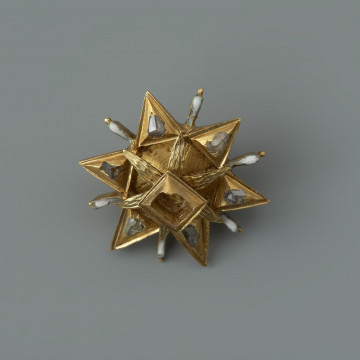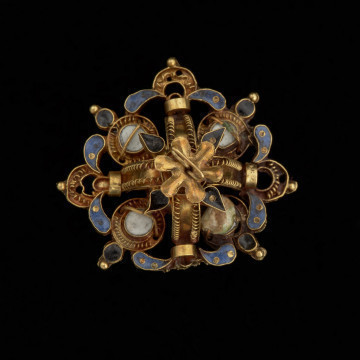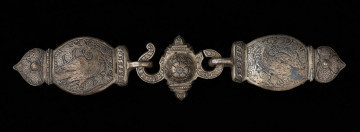
Star-shaped dress jewellery
nie po 1637
National Museum in Szczecin
Part of the collection: Jewels and costumes of Pomeranian dukes
In the sarcophagus of Duke Frantis I of Pomerania, besides spectacular jewels such as diamond-studded cap ornaments, magnificent chains with pendants and bracelets, three small golden rosettes in the form of flowers made of twelve petals decorated with cellular enamel, inlaid with gold dots, pearls and spirally wound wire were found. The white enamelled petals forming the convex centres of the flowers, originally interacted with the pearls, of which only one has survived to our times.These types of small jewels were called dress jewels or trinkets. Loops of wire soldered at the bottom were used to sew them onto the costume. Dress jewels could create a decorative pattern on fabric, they were also used to fasten bows or lace rosettes. Similar sized gold trifoliate rosettes decorated with enamel were used to fasten rosettes to the shoes of Francis I. So far it has not been possible to establish the location of the dress jewels on the Prince's attire. In the posthumous portrait of the sovereign from 1621 from the collection of the cathedral in Merseburg, a small rosette decorated with pearls can be seen - below the prince's hand, next to the date 1620. However, it is difficult to say whether it is the same as one of the three preserved dress jewels, and what function it had in this place of the costume.
Monika Frankowska-Makała
Author / creator
Dimensions
cały obiekt: diameter: 1,4 cm
Object type
aiglet, jewellery
Creation time / dating
Creation / finding place
Identification number
Location / status

nie po 1637
National Museum in Szczecin

nie po 1637
National Museum in Szczecin

około 1600
National Museum in Szczecin
DISCOVER this TOPIC
Museum of King Jan III's Palace at Wilanów
DISCOVER this PATH
Educational path